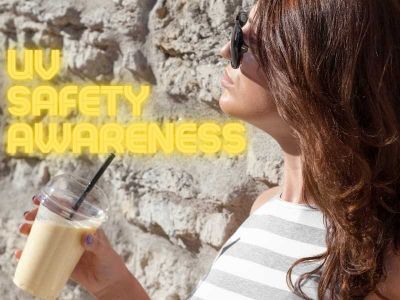Jul 1st, 2022
July is (Ultraviolet) UV Safety Awareness Month! Please help the Cape Girardeau County Public Health Center spread awareness about the dangers of UV light exposure and how important it is to protect our eyes and skin from the sun's harmful rays.
Ultraviolet (UV) rays are an invisible kind of radiation that comes from the sun, tanning beds, and sunlamps. UV rays can penetrate and change skin cells. There are three types of UV rays:
- Ultraviolet A (UVA). UVA rays penetrate deep into the layers of the skin and lead to premature signs of aging, which include fine lines and wrinkles. Tanning beds work by emitting primarily UVA rays.
- Ultraviolet B (UVB). UVB rays penetrate the outermost layer of skin and cause damage to skin cells. It's the primary cause of sunburn, thickening of the skin, and several types of skin cancers; and can cause damage to eyes and the immune system.
- Ultraviolet C (UVC). UVC is the strongest of the UV spectrum radiation and can cause severe skin burns and eye injuries. The penetration depth of UVC rays is very low, so injuries usually resolve with virtually no risk of long-term health risks. The only way we can be exposed to UVC radiation is from an artificial source, such as a lamp or laser.
What to know
The strength of the sun's UV rays reaching the ground depends on a number of factors, such as:
- Time of day (strongest in the middle of the day between 10am and 4pm)
- Season (stronger during Spring and Summer)
- Latitude (less exposed as you get further from the equator)
- Altitude (more exposed in higher elevations)
- Cloud cover (affects can vary but UV rays can reach the ground even on a cloudy day)
- Reflection (stronger when rays bounce of surfaces like water, sand, snow, or pavement)
Some people think about sun protection only when they spend a day at the lake, beach, or pool. But sun exposure adds up day after day, and it happens every time you are in the sun.
How to protect yourself
There are some simple steps you can take to limit your exposure to UV rays.
- Seek shade. Especially during sun peak times, 10am to 4pm, avoid being outdoors in direct sunlight or opt for shade.
- Slip on a shirt. Use clothing to cover your skin but if you can see through a fabric, UV rays can get through too.
- Use sunscreen. It protects skin from sun's UV rays (more on this below).
- Wear sunglasses. Look for 99-100% UVA/UVB protection and wrap-around styles.
- Wear a hat. Look for at least a 2-3 inch brim all around to protect your eyes, ears, forehead, nose and scalp.
- Never look directly at the sun. This may cause damage to the eye's retina.
- Avoid tanning beds and sun lamps. To appear tan, opt for sunless tanning lotions instead.
Sunscreen tips
Sunscreen should not be used as a way to prolong your time in the sun. Even with proper sunscreen use, some UV rays still get through. Because of this, sunscreen should not be thought of as your first line of defense. Still, it's a valuable level of protection.
Read the labels
Check for SPF, broad spectrum, water resistance, and expiration dates. SPF values of 30 or higher are recommended. "Broad spectrum" protection can only be labeled as such if they have been tested and shown to protect against both UVA and UVB rays. Water resistance must state whether they protect the skin for 40 or 80 minutes of swimming/sweating based on testing. Most sunscreen is good for 2-3 years but check the expiration date to ensure that it's still effective. No sunscreens protects you completely.
Apply it properly
Always follow the label for directions and apply sunscreen generously (about 1 ounce or palmful to cover arms, legs, neck and face for the average adult). Some sunscreen products can irritate skin so always be sure to read the label.
We want you to enjoy your Summer! We want you to be healthy too. That's why it's important to know about overexposure to UV rays and how to keep our skin and eyes protected—especially during UV Safety Awareness Month.
If you are having any problems after being in the sun, be sure to talk to your healthcare provider.
Source: American Cancer Society and Summit Medical Group

